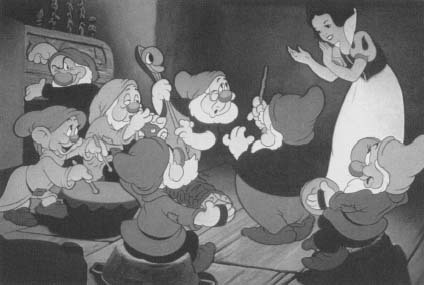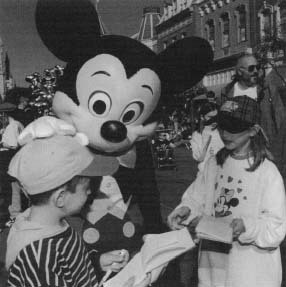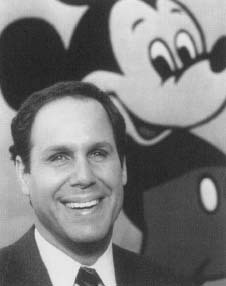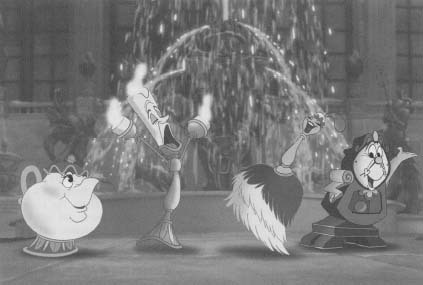Walt Disney Company
500 South Buena Vista Street
Burbank, CA 91521
(818) 560-1000
www.disney.go.com
Starting with animated films featuring animals, including a particularly famous white-gloved mouse, the Walt Disney Company grew to become a leading provider of all forms of family entertainment. It also established one of the world's best-known and respected brand names. People from around the globe flock to Disney theme parks and Disney movies, and in most countries at any given time, someone is bound to be sporting a T-shirt or watch featuring Mickey Mouse, Goofy, Pluto, or any one of the dozens of well-known Disney characters. The man behind the vision was animator Walt Disney, who turned a small company into a part of American popular culture.
A Mouse Leads the Way
Walt Disney had already failed running one animation company when he reached Hollywood, California, in 1923. His brother Roy (1893-1971) was already living there, and together they formed the Disney Brothers Studio. Walt was the artist, creating characters and developing stories, while Roy handled the business affairs, especially raising money. The brothers signed a deal to make cartoons, receiving $1,500 per reel of film.
In 1926, Disney Brothers Studio became Walt Disney Studios (and later Walt Disney Productions), reflecting Walt's role as the creative force. In 1927, he created a cartoon character called Oswald the Lucky Rabbit, who starred in more than two dozen cartoons. The company's big break, however, came in 1928, with the first appearance of Mickey Mouse. Mickey appeared in two silent cartoons before starring in Steamboat Willie, the first cartoon with sound. (The first film with sound, The Jazz Singer, had been released the year before.) By this time, Disney was no longer drawing cartoons himself. He relied on other artists, particularly longtime friend Ub Iwerks (1901-1971). But Disney remained directly involved in creating the stories for his cartoons, and insisted on the highest quality possible.
Steamboat Willie was a sensation, and quickly led to more Mickey Mouse cartoons and other talking animal characters. In 1929, a stationery company saw the value of putting Mickey's face on pads of paper. Disney sold the company the right to use the mouse's image for $300. Within a few years, Disney hired an advertising company to put Disney characters on other products, and soon Disney Productions earned about 10 percent of its income from these licensing deals.
Walt Disney at a Glance
- Employees: 114,000
- CEO: Michael Eisner
- Subsidiaries: ABC Holding Company, Inc.; ABC, Inc.; American Broadcasting Companies, Inc.; Buena Vista Home Entertainment, Inc.; Disney Enterprises, Inc.; ESPN, Inc.; Walt Disney World Company
- Major Competitors: DreamWorks SKG; Vivendi Universal; Viacom; AOL Time Warner; Comcast; News Corporation; Bertelsmann AC
- Notable Products and Companies: Theme parks: Disneyland, Disney's California Adventure, Disney World, Disneyland Resort Paris, Tokyo DisneySea, EPCOT; TV networks: ABC, ABC Family Channel, ESPN, The Disney Net work; Film production companies: Walt Disney Pictures, Touchstone Pictures, Hollywood Pictures, Miramax; Record companies: Hollywood Records, Buena Vista Records; Hyperion publishing; Disney Online; Disney Cruise Line
While expanding into other businesses, Disney did not ignore its primary purpose: to make movies. By 1931, the studio staff totaled seventy-five employees. The next year, the company released the first full-color cartoon, Flowers and Trees. The cartoon won an Academy Award, filmmaking's highest honor. In 1937, Disney made the world's first full-length animated film, Snow White. Other filmmakers thought Disney could not come up with a good enough story to entertain people with a long cartoon, and they nicknamed the film "Disney's Folly." Snow White, however, was a huge hit, and was followed by Pinocchio and Fantasia, both released in 1940.
Timeline
- 1923:
- With his brother Roy, Walt Disney forms Disney Brothers Studio, which later becomes the Walt Disney Company.
- 1928:
- Steamboat Willie, featuring Mickey Mouse, is the world's first cartoon with sound.
- 1937:
- Disney releases Snow White, the first full-length animated movie.
- 1955:
- Disneyland opens in Anaheim, California.
- 1966:
- Walt Disney dies.
- 1971:
- Disney World opens in Orlando, Florida.
- 1984:
- Michael Eisner becomes CEO of Disney.
- 1994:
- Beauty and the Beast is Disney's first Broadway musical.
- 1995:
- Disney buys the ABC television network, which also gives it control of ESPN and other cable networks.
- 1998:
- Disney launches its own cruise line.
Wartime Efforts
The success of Snow White allowed Disney to build a new $3 million studio in Burbank, California. The studio featured plush working conditions for the time, including air conditioning and a cafeteria that delivered to workers' desks. But by 1941, workers were demanding better pay as well. A strike at the studio upset Disney for several reasons: the company was already in debt, plus Disney felt that he had always tried to treat his workers well.

The strike ended just before the United States entered World War II (1939-45). During the war, the Disney company produced animated training films for the government, as well as entertainment. Some of the Disney cartoons served as propaganda, reminding Americans how to contribute to the war effort and making fun of the country's enemies. Disney's major theatrical release during the war was Bambi, which featured some of the studio's most realistic drawings of animals.
After the war, with Disney Productions still in debt, the company began to make its first live-action films. Some were "true life" stories, featuring animals or people in exotic locations. The first of these, Seal Island, was released in 1948. Two years later, Disney produced its first live-action story, Treasure Island, based on the classic book by Robert Louis Stevenson (1850-1894). Even as the company moved beyond cartoons, it stayed true to its roots of offering well-made family entertainment.

Disneyland, Television, and the Future
By the early 1950s, Walt Disney had a creative vision. He wanted to build an amusement park tied to different Disney products that recreated the look and feel of a small American town. The final product was Disneyland, built for $17 million dollars in Anaheim, California. The park opened in 1955, and within a year it earned $10 million—one third of Disney's total revenue.
The money needed to build Disneyland forced Disney Productions to take on a partner. ABC, a television network, invested in the park and loaned Disney money in return for one-third ownership (the company later sold its share back to Disney). The deal also led to a weekly Disney television program on ABC, called Disneyland. The show featured clips from Disney movies and new programs filmed for television. Walt Disney introduced each show, which made him an instant celebrity. For three years, the program was ABC's most popular program; it ran under different names until 1981. A new version appeared in the 1990s.
Soon Disney began producing other TV shows, such as Zorro and The Mickey Mouse Club, featuring the "Mouseketeers." These young actors sang, joked, and performed in sketches. They were known by the hats they wore, which looked like Mickey Mouse's ears. Disney Studios also made new films, including the musical comedy Mary Poppins (1964), which was nominated for thirteen Academy Awards. The success of such films helped Disney get out of debt in the early 1960s.
By this time, Walt Disney was moving out of film production to concentrate on building his own community. He called the town the Environmental Prototype Community of Tomorrow (EPCOT). Disney was actively involved in designing Epcot when he died in 1966.
Disney after the Disneys
The death of Walt Disney left Roy 0. Disney in charge. He died in 1971, just after the opening of Disney's second theme park, Disney World, in Orlando, Florida. E. Cardon Walker, a longtime employee, then took over as president of the company. Roy E. Disney (1930-), the son of Walt's brother, also had a key role as vice president of animation. Walker tried to run the company as he thought Walt would have, although he lacked Disney's creative genius. For several years, the films Walker chose to make did well, but after 1974, his family-oriented fantasies and comedies were flops, considered old-fashioned by many kids and teens.
By 1979, the company had the worst sales of all the major film producers. Disney was also struggling to build EPCOT and eventually spent more than $1 billion to complete it. As business suffered, the company spent less money maintaining its two theme parks, and revenues there also fell.
One of the first Disneyland television shows was about the historic frontiersman Davy Crockett. It soon became a huge hit and sparked a national fad as boys and girls clamored for coonskin caps similar to the one Crockett wore on the show. Disney was only too happy to oblige.
In 1983, Walt Disney's son-in-law, Ron Miller, was elected the new chief executive officer (CEO). Miller had already

Disney and Gold were not alone. Other prominent investors, including Saul Steinberg, Irwin Jacobs, and the Bass family of Texas, bought shares in the company, hoping to make a profit. When the dust settled, Disney united with Bass to win control of the company in 1984. One of their first moves was replacing Ron Miller with Michael Eisner, a former executive at Paramount Pictures. Assisting him was Frank
Wells, who had played a part in organizing Roy Disney's takeover bid.
Rebirth of a Company
Eisner, like Walt Disney, had a strong creative streak, although he also had Roy 0. Disney's business sense. Eisner carried out Miller's plan of re-releasing old Disney films on videotape, then strengthened the animation division. He put Jeffrey Katzenberg (see DreamWorks SKG entry), another former Paramount executive, in charge of film production. Katzenberg was able to make money by spending much less than other studios on salaries and production. Eisner's other moves included boosting advertising for Disney's theme parks and producing the hit TV show, The Golden Girls. By the end of 1986, company revenues reached $2.4 billion.
Eisner, however, was just starting his ambitious program to expand the Disney company. That year, Disney changed its

The new projects continued during the 1990s. The company bought a hockey franchise and named it after a team featured in one its movies, the Mighty Ducks. Later, Disney bought a baseball team, the California Angels. In film production, a new wave of quality animated films led to strong boxoffice revenues and new licensing fees. The company also took control of Miramax, a film company known for its intelligent, smaller-budget films. Disney had a new hit TV show with Home Improvement, and it launched its own publishing company, Hyperion. By 1993, revenues reached $8.5 billion, with a larger percentage coming from international operations than in the past.
The next year, Disney released The Lion King, the top movie of the year. The soundtrack recording of The Lion King reached number one, and a Broadway play based on the movie was also a hit. Disney first came to Broadway in 1994, producing a musical based on its film version of Beauty and the Beast. The same year, the company bought a Broadway theater, helping to revitalize New York's Time Square area.
With its growth and power, Disney under Eisner developed a reputation for being tough. The company's movies continued to cost less to make than other film studios, and it drove hard bargains with partners and distributors. In 1995, Eisner told Fortune, "If you're soft and fuzzy, like our characters, you become the skinny kid on the beach, and people in this business don't mind kicking sand in your face." At the same time, however, Eisner was earning huge salaries, most of it tied to Disney stock. To some people, he became a symbol of the growing gap in pay between America's chief executive officers and its average workers.
Disney around the World
In 1983, Disney's first overseas theme park opened, in Tokyo, Japan. Although it did not own the park, Disney made money managing it. Its second major foreign development was Euro Disney, built outside Paris, France, and later renamed Disneyland Resort Paris. The park opened in 1992 and lost money at first, but eventually generated a profit for the company. Disney opened a second theme park in Tokyo in 2001, and made plans to open a park in Hong Kong. In March 2002, the company launched a second theme park near Paris called Walt Disney Studios Park.
New Worlds to Conquer
Disney moved farther into television with its 1995 purchase of Capital Cities/ABC for $19.6 billion. The network owned several cable channels, including the hugely successful sports network, ESPN. The company also built a sports complex in Florida and opened a planned community, Celebration. The town, built from scratch, was located just outside Walt Disney World. Already part of the travel industry with its theme parks and hotels, Disney started its own cruise line in 1998. That year, Disney also took a large step into the Internet, buying a large portion of search engine company Infoseek, so it could begin displaying its content on the World Wide Web—and create more demand for its products. In 2001, a second park opened in California—Disney's California Adventure.
Creating a multimedia empire, however, led to problems. By 1999, Eisner was looking for a way to cut costs to ensure future profits. The year before, sales had grown to $23 billion and profits were more than $1 billion. Still, business analysts complained about the company's direction. In 2001, Disney suffered when the September 11 terrorist attacks cut revenues at its theme parks. And while a few of its animated films were successful, none matched the popularity of The Lion King or Beauty and the Beast. Top executives, however, remained confident. Robert Iger, company president, told Fortune in January 2002, "We have an unbelievable array of brands to drive growth and operating income." Around the world, the name Disney still meant fun, wonder, and a sense of magic.
I WNAT TO BE LIKE HIM AND ONE DAY I WILL BECOME THE ANIMATOR.
JUST LIKE HIM.